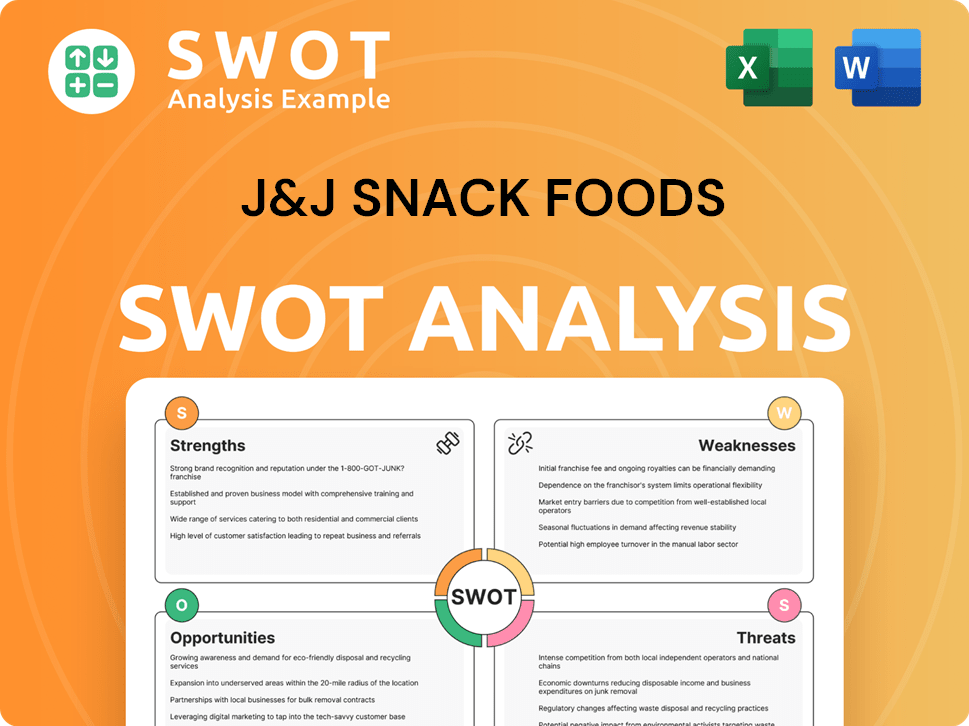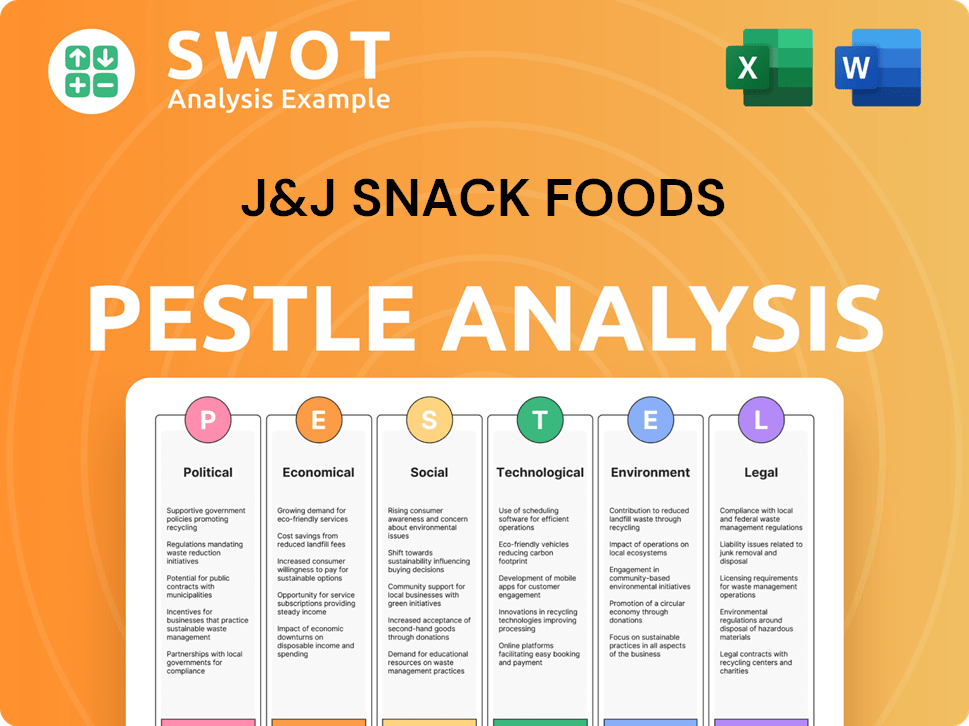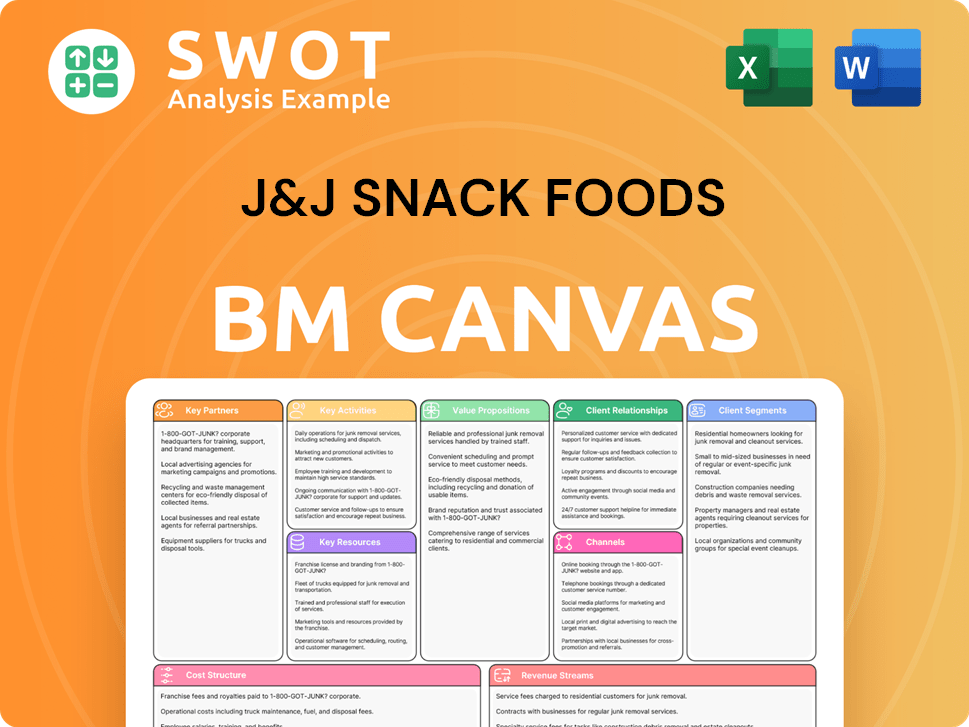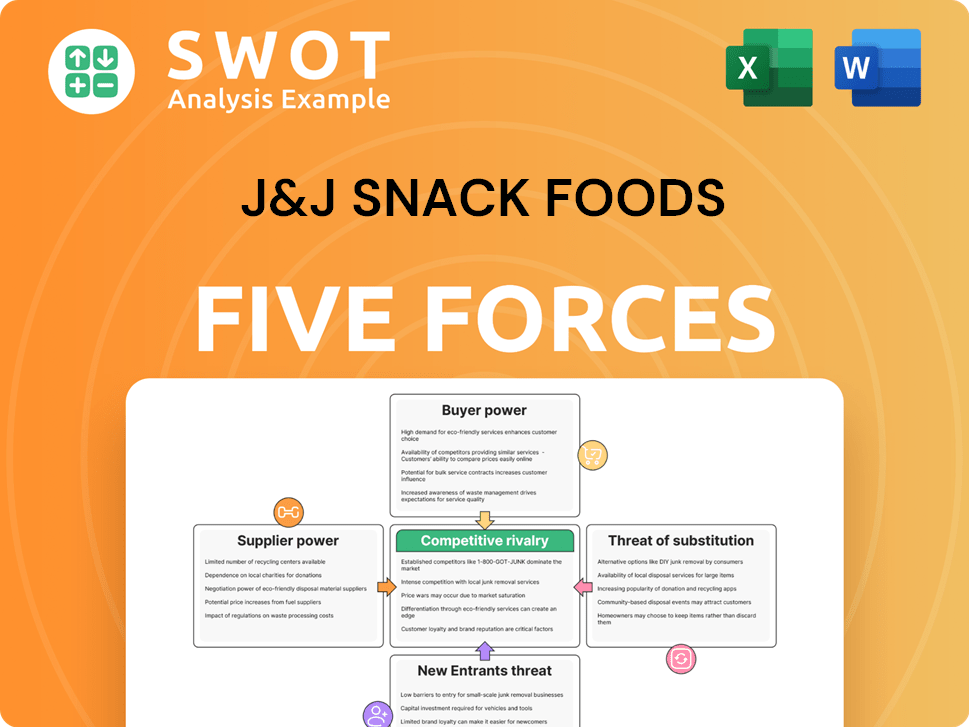J&J Snack Foods Bundle
Who Buys SUPERPRETZEL and Beyond? Unveiling J&J Snack Foods' Customer Base
The J&J Snack Foods SWOT Analysis reveals a fascinating story of adaptation in the dynamic snack food industry. Understanding the customer demographics and target market is crucial for any company aiming for sustained success. Let's delve into the evolving landscape of J&J Snack Foods Company and explore the key factors shaping its consumer profile.

From stadiums to supermarkets, J&J Snack Foods has strategically broadened its reach, making it essential to understand its target audience. This analysis will explore who J&J Snack Foods' customers are, examining their geographic location, age range, income levels, and lifestyle. We'll also investigate how the company segments its market and tailors its marketing strategies, providing insights into the factors influencing customer buying behavior within the snack food industry.
Who Are J&J Snack Foods’s Main Customers?
Understanding the customer demographics and target market of J&J Snack Foods Company is crucial for assessing its market position. The company operates in both the business-to-consumer (B2C) and business-to-business (B2B) sectors, each with distinct customer profiles. This dual approach allows J&J Snack Foods to capture a broad market share within the snack food industry.
In the B2B segment, J&J Snack Foods focuses on food service operators. These include a variety of venues such as schools, entertainment complexes, and convenience stores. This market segment benefits from bulk purchases of products like soft pretzels and frozen beverages, offering convenience and profitability to the businesses. The company's strategy includes tailored offerings to meet the specific needs of each venue, ensuring product alignment with consumer preferences.
The B2C segment targets individual consumers through retail channels, primarily supermarkets. This segment includes families and individuals looking for convenient snack options for at-home consumption. Products such as LUIGI'S Real Italian Ice and Minute Maid ices appeal to a broad demographic. Recent financial data shows the effectiveness of this strategy, with retail sales increasing significantly in recent periods.
The B2B segment includes schools, universities, hospitals, convenience stores, movie theaters, amusement parks, and stadiums. These customers purchase products in bulk for resale. This sector benefits from the high demand for convenient snacks and beverages.
The B2C segment targets individual consumers through retail channels. This includes families and individuals seeking convenient snack options. Products like LUIGI'S Real Italian Ice and Minute Maid ices appeal to a broad demographic.
J&J Snack Foods has a broad geographic reach, with distribution across the United States and internationally. The company's products are available in various retail and food service locations, reflecting a wide distribution network. This extensive reach supports its diverse customer base.
Product preferences vary by demographic, with younger consumers often favoring frozen treats and soft pretzels. The company's diverse product range caters to different tastes and preferences. This strategy helps maintain market share.
J&J Snack Foods segments its market to target both businesses and individual consumers effectively. This dual approach allows for a wide reach across various demographics. Understanding these segments is key to the company's market segmentation strategy.
- Schools and Universities: Bulk purchasers of snacks and beverages.
- Retail Consumers: Families and individuals seeking convenient snack options.
- Entertainment Venues: Customers looking for enjoyable snack options during outings.
- Convenience Stores: Offering quick and easy snack solutions.
For a deeper dive into how J&J Snack Foods is growing, consider exploring the Growth Strategy of J&J Snack Foods. This article provides valuable insights into the company's expansion plans and market strategies.
J&J Snack Foods SWOT Analysis
- Complete SWOT Breakdown
- Fully Customizable
- Editable in Excel & Word
- Professional Formatting
- Investor-Ready Format

What Do J&J Snack Foods’s Customers Want?
Understanding the customer needs and preferences is crucial for the success of any company, and it is particularly important for a company like J&J Snack Foods Company. The company's approach to the snack food industry revolves around meeting the diverse needs of its customers, from those in the foodservice sector to retail consumers. This involves a deep dive into what drives their purchasing decisions, ensuring that products meet expectations for taste, convenience, and value.
The target market for J&J Snack Foods Company is broad, encompassing both business-to-business (B2B) and business-to-consumer (B2C) segments. The company's success is built on its ability to cater to these varied needs, offering products that resonate with consumers across different demographics and preferences. This includes a focus on brand recognition and the ability to provide consistent quality and availability.
The primary drivers for customers of J&J Snack Foods Company are convenience, taste, and value. In the B2B foodservice sector, operators prioritize products that are easy to prepare and have a long shelf life. In the retail sector, consumers often make impulse buys, seeking quick and satisfying snacks. This understanding of consumer behavior helps the company tailor its marketing and product offerings to meet those needs effectively.
Foodservice operators look for products that are easy to prepare and have a long shelf life. This minimizes waste and maximizes sales volume, which is crucial for profitability. Products like soft pretzels and frozen novelties are often chosen for their ease of use.
Established brands like SUPERPRETZEL and ICEE build consumer trust. This recognition often leads to higher purchasing intent, making these brands valuable assets. The familiarity of these brands influences customer choices.
Retail consumers often make impulse purchases, seeking quick snacks. Flavor variety and perceived value for money are key decision-making factors. Products must be appealing and offer a satisfying experience.
Products like LUIGI'S Real Italian Ice are chosen for their refreshing qualities, making them suitable for families. This appeals to parents looking for treats for their children. The focus is on providing enjoyable experiences.
The company addresses pain points by offering readily available, consistent quality snack options. This is critical across various venues and for convenient at-home consumption. The focus is on providing solutions.
Marketing emphasizes the nostalgic appeal of brands like ICEE and the convenience of soft pretzels. This positions products as ideal for various occasions, from sporting events to family gatherings. The goal is to connect with consumers emotionally.
The Marketing Strategy of J&J Snack Foods is designed to meet the demands of its diverse customer base. The company's approach is to provide snack options that are not only convenient and tasty but also offer good value. This strategy helps the company maintain a strong position in the competitive snack food industry. For example, in 2024, the snack food industry in the U.S. generated over $400 billion in revenue, indicating the substantial market opportunity. J&J Snack Foods Company's ability to understand and respond to customer needs is a key factor in its success.
The customer needs and preferences of J&J Snack Foods Company are centered around convenience, taste, and value. These factors drive purchasing decisions across both B2B and B2C sectors. Understanding these needs is critical for the company's marketing and product development strategies.
- Convenience: Easy-to-prepare products with long shelf lives for foodservice operators.
- Taste: Flavor variety and satisfying experiences for retail consumers.
- Value: Products that offer a good price-to-quality ratio.
- Brand Recognition: Established brands that build consumer trust and drive purchasing intent.
- Availability: Consistent quality and availability of snack options across various venues.
J&J Snack Foods PESTLE Analysis
- Covers All 6 PESTLE Categories
- No Research Needed – Save Hours of Work
- Built by Experts, Trusted by Consultants
- Instant Download, Ready to Use
- 100% Editable, Fully Customizable

Where does J&J Snack Foods operate?
The primary geographical market for the J&J Snack Foods Company is North America, with a significant presence across the United States. Its distribution network ensures that its products are readily available in various states and regions. This widespread availability is key to its market penetration within the snack food industry.
The company's products are commonly found in high-traffic locations such as amusement parks, stadiums, and movie theaters. This extensive reach helps build brand recognition and supports its substantial market share. The company's success is evident in its financial performance, with net sales increasing in recent periods.
While specific expansions and withdrawals aren't always detailed in public reports, the company's consistent revenue growth indicates a robust market presence. For instance, in the first quarter of fiscal year 2024, net sales increased by 11% to $305.8 million, demonstrating solid market penetration across its established geographical footprint. Understanding the Brief History of J&J Snack Foods provides additional context.
The company concentrates its efforts primarily within the North American market. This strategic focus allows for efficient distribution and targeted marketing efforts. The company's market segmentation strategy is heavily influenced by regional preferences and consumer behavior.
J&J Snack Foods Company utilizes extensive distribution networks to reach both foodservice establishments and retail supermarkets. This comprehensive approach ensures that products are available to a wide range of consumers. The company's ability to adapt to different distribution needs supports its market share.
The company adapts its offerings to suit regional tastes and preferences. While core products maintain broad appeal, regional variations in demand exist. This adaptation is crucial for maintaining and expanding its customer base within the competitive snack food industry.
The company's consistent revenue growth indicates strong market penetration across its established geographical footprint. The company's ability to maintain and grow its market share is a testament to its effective strategies. The company's success is tied to understanding the customer demographics.
While specific expansion details are not always public, the company's overall growth demonstrates its ability to adapt and expand. This growth is supported by effective distribution and a focus on customer needs. The target market is continuously assessed.
The financial performance, such as the 11% increase in net sales to $305.8 million in the first quarter of fiscal year 2024, reflects its market success. This financial growth is supported by strong distribution and brand recognition. Understanding customer demographics is key.
J&J Snack Foods Business Model Canvas
- Complete 9-Block Business Model Canvas
- Effortlessly Communicate Your Business Strategy
- Investor-Ready BMC Format
- 100% Editable and Customizable
- Clear and Structured Layout

How Does J&J Snack Foods Win & Keep Customers?
Customer acquisition and retention strategies for the company involve distinct approaches tailored to its business-to-business (B2B) and business-to-consumer (B2C) segments. For B2B clients, the company focuses on direct sales, industry trade shows, and long-term contracts. These strategies highlight the profitability and ease of integrating their products. For the B2C sector, the company uses in-store promotions, digital marketing, and brand recognition to attract and retain customers.
The company's established brand names like SUPERPRETZEL and ICEE are key for acquisition, leveraging existing consumer trust. Retention strategies center on delivering high-quality products and fostering repeat purchases. Product innovation and diversification, such as new bakery items and frozen novelties, further contribute to maintaining customer interest. The company is a significant player in the snack food industry, with a focus on both retail and foodservice channels. Understanding the customer demographics and target market is essential for their continued success.
The company’s approach to customer acquisition and retention is multifaceted, incorporating both traditional and modern marketing techniques. The company's ability to maintain a strong market position is influenced by factors such as consumer preferences, competition, and economic conditions. To gain a deeper understanding of the company's business model, you can explore the Revenue Streams & Business Model of J&J Snack Foods.
Direct sales teams and participation in industry trade shows are key for attracting B2B clients. Long-term contracts, based on volume and product quality, ensure steady revenue. The company emphasizes the ease of integrating its products for foodservice businesses.
In-store promotions and digital marketing are used to reach consumers directly. Established brands like LUIGI'S and WHOLE FRUIT are powerful acquisition tools. The company leverages consumer familiarity and trust to drive sales.
Consistently delivering high-quality products is crucial for repeat purchases. Product innovation, such as new bakery items and frozen novelties, keeps customers engaged. The company aims to maintain customer loyalty through product excellence.
The company's established brands provide a significant advantage in the market. Brand recognition helps in acquiring new customers. Familiarity with brands like SUPERPRETZEL and ICEE drives consumer trust.
J&J Snack Foods Porter's Five Forces Analysis
- Covers All 5 Competitive Forces in Detail
- Structured for Consultants, Students, and Founders
- 100% Editable in Microsoft Word & Excel
- Instant Digital Download – Use Immediately
- Compatible with Mac & PC – Fully Unlocked

Related Blogs
- What are Mission Vision & Core Values of J&J Snack Foods Company?
- What is Competitive Landscape of J&J Snack Foods Company?
- What is Growth Strategy and Future Prospects of J&J Snack Foods Company?
- How Does J&J Snack Foods Company Work?
- What is Sales and Marketing Strategy of J&J Snack Foods Company?
- What is Brief History of J&J Snack Foods Company?
- Who Owns J&J Snack Foods Company?
Disclaimer
All information, articles, and product details provided on this website are for general informational and educational purposes only. We do not claim any ownership over, nor do we intend to infringe upon, any trademarks, copyrights, logos, brand names, or other intellectual property mentioned or depicted on this site. Such intellectual property remains the property of its respective owners, and any references here are made solely for identification or informational purposes, without implying any affiliation, endorsement, or partnership.
We make no representations or warranties, express or implied, regarding the accuracy, completeness, or suitability of any content or products presented. Nothing on this website should be construed as legal, tax, investment, financial, medical, or other professional advice. In addition, no part of this site—including articles or product references—constitutes a solicitation, recommendation, endorsement, advertisement, or offer to buy or sell any securities, franchises, or other financial instruments, particularly in jurisdictions where such activity would be unlawful.
All content is of a general nature and may not address the specific circumstances of any individual or entity. It is not a substitute for professional advice or services. Any actions you take based on the information provided here are strictly at your own risk. You accept full responsibility for any decisions or outcomes arising from your use of this website and agree to release us from any liability in connection with your use of, or reliance upon, the content or products found herein.